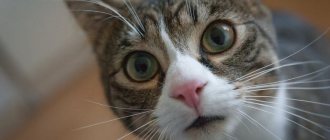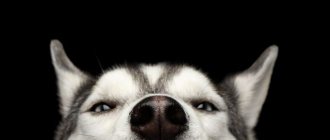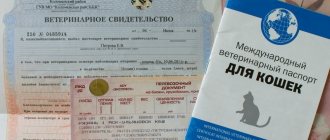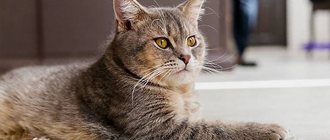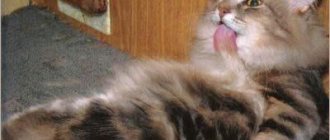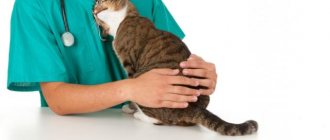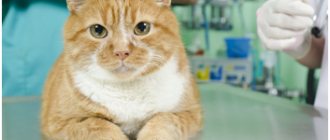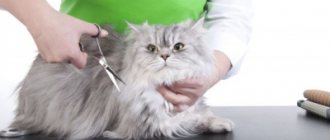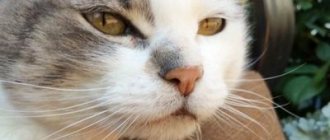Many owners of furry (or not so fluffy) pets are inclined to believe that the health of the cat can be judged by the condition of the nose. In addition, some people mistakenly believe that a dry, hot nose indicates that the animal has an elevated temperature.
Ideally, your cat's nose should be moist and cool. Sometimes during sleep or immediately after it, the nose may be slightly dry and warm (hot) to the touch. This is not some kind of pathology and does not indicate a painful condition of the pet.
A dry and hot nose should only cause concern if it lasts for quite a long time, and the cat is very depressed, inactive, eats poorly and lies a lot.
Very often, a nose that remains dry for a long time may indicate a fever and severe dehydration of the pet’s body.
What could be a reason for concern?
By changing the temperature of the humidity of the nose, you can trace some of the processes occurring in the pet’s body. Sometimes this can be one of the signs that your pet is sick. It is necessary to understand in general terms when to worry and when not to.
The main symptoms at which the disease begins to progress:
- Goes to the toilet often or rarely.
- Diarrhea or bloody discharge.
- The cat is constantly in a tense state of stress.
- Excessive hair loss.
- Vomit.
- Deep breathing.
The temperature of the nose can change throughout the day, so there is no need to panic if your pet has just woken up and has a dry nose, as everything will be back to normal in a couple of hours.
There is a scientific explanation for this: during sleep the animal is at rest, its body temperature rises, partial dehydration of the body occurs due to insufficient water, and after waking up all biochemical processes are restored.
A cold nose can be a sign of a disease, but it is also accompanied by other symptoms, such as diarrhea, vomiting, fever, weakness, and lethargy.
Expert opinion
Irgutanova Nina Nikolaevna
Practicing veterinarian, 13 years of experience.
In this case, it is recommended not to undertake independent treatment from the Internet, but rather contact a veterinarian for qualified help.
A cold nose in itself should not be a cause for concern, as it may be a completely normal reaction. The disease can be determined by observing the accompanying symptoms with a low nose temperature, for example colds:
- You should feel your ears; they may be hot.
- The cat eats little, is less mobile, lethargic.
- Snorts or sneezes frequently.
- High body temperature.
Body temperature is measured not by the animal's nose, but by a thermometer. The usual one used by people is suitable for this.
Nutrition
A cold nose in combination with other symptoms is an indicator that may indicate a weakened immune system . Owners who don’t bother about their cat’s diet prefer to limit themselves to buying dry food. Dry food causes dehydration of the body, followed by failure of internal organs. It is recommended to dose the daily amount of dry food with regular homemade food. Cats are predators, so the body requires natural food - meat.
Proper nutrition helps a cat build normal organ functioning, increase resistance to diseases, withstand negative environmental influences and always be in good shape.
What can affect the temperature of a cat's nose?
Many owners believe that if a cat has a hot nose, then it is sick. However, not all so simple.
Dryness can also be caused by completely natural reasons, but to more accurately determine the pet’s condition, you need to pay attention to other signs. Only a combination of several symptoms can more or less accurately indicate health problems in your pet.
The level of humidity of the mirror can change several times a day even in a completely healthy cat.
A cat's nose is dry and warm usually in the following cases:
- if she is sleeping;
- for some time (about thirty minutes) after waking up;
- after serious physical activity, the temperature rises, which leads to dryness of the mirror;
- do not be surprised if the cat’s nose is dry and warm if it is in a hot and stuffy room;
- after suffering severe stress.
Frequent dryness of the nose is a normal situation for older animals. Cats love to sit on radiators or other heating devices - naturally, their nose will be hot at this time.
Expert opinion
Kalado Irina Sergeevna
Practicing veterinarian, 13 years of experience.
This is interesting! Cats with a flattened muzzle often have a wet nose. This can be explained very simply: they simply have the opportunity to lick it.
Nasal discharge in a cat
If your pet has nasal discharge, swelling, or is having trouble breathing, it's time to call your veterinarian. These signs indicate the presence of a foreign body inside, infection or even a tumor. If discharge appears from only one nostril, then it may be a foreign body stuck inside. Other signs of these illnesses include sneezing, nose picking, or bleeding. Nasal polyps or tumors often coincide with bloody discharge or mucus from the inside, the cat's breathing becomes noisy, and a bulge or bump may appear on one side of the face.
Check your cat's nose often
Examination of an animal’s olfactory organ is an obligatory part of home life. Knowing the appearance and shape of a cat's nose when it is healthy makes it easier to determine when disease appears. Examine and look for unusual signs, such as nasal discharge, especially if it changes from clear to mucous or bloody, and watch for excessive dryness, crusting, or loss of pigmentation.
Healthy cat nose
Watch your breath
It is also important to monitor how the animal breathes. A healthy cat should breathe through its nose. If the nostrils flare more than usual, your pet may have trouble breathing. It is worth noting that while waiting for the veterinarian, it will not be a bad idea to use vitamin E. You can open the capsule and drop it into the cat’s nose.
It must be remembered that a cat’s nose that is too dry or wet can be a symptom of serious illnesses that cannot be cured on your own. Therefore, at the first suspicion of a disease, the cat should be shown to a veterinarian.
This is interesting: The cat has a clear liquid flowing from its nose
When there is no reason to worry
Speaking about what the nose of a healthy cat should be like, it should be noted that situational changes in its temperature and humidity are not always a direct sign of the presence or development of any disease in the animal. Thus, the nose of kittens is often hotter than the nose of an adult animal.
Also, any kind of stress, increased physical activity and even ordinary sleep make it dry and hot, which, however, does not in any way affect the pet’s health.
Norm or pathology
The sense of smell in cats is the main sense organ. An animal that has difficulty smelling becomes lethargic, has poor spatial orientation, and loses its appetite. If the olfactory organ is moist and cool, this means that the pet is healthy . Due to the emotional state, physical activity, and climatic conditions, indicators can change over time, but this is not always a sign of pathology.
Minor dryness goes away on its own or after favorable conditions are created.
Important. Even overeating or eating a small portion of food can affect humidity.
Pets on dry food are more likely to have health problems. To improve their condition, they need plenty of fluids; if there is no desire, the animal can be fed from a syringe without a needle.
If deviations in the cat’s behavior, lethargy and apathy are noticed, then he should be monitored for 2 days. During this period, in the absence of diseases, the moisture in the nose is restored.
Many people believe that sick cats' noses become dry and hot. This is not entirely true. Sometimes an animal is diagnosed with a wet nose, but other signs indicate the presence of pathology. In this case, consultation with a veterinarian is required.
This is interesting: Cats have sores on their noses
Nose of a healthy animal
In terms of its structure, a cat’s nose is no different from a human’s: two nasal passages separated in the middle by cartilage.
The differences start further. These passages lead into a labyrinth of lattice shells that are very sensitive. If necessary, cats can retain a particular smell and even filter it from impurities in order to sense it as accurately as possible.
Contaminants on the surface of the nose reduce its sensitivity, so it should always be clean.
A healthy cat's nose performs many other tasks. For example, the air inhaled by an animal is purified and heated.
The outer skin is highly sensitive to temperature, so it is easy for your pet to determine what kind of food is in front of them without even touching it.
The shape of a cat's nasal cavity may vary depending on the breed. The healthiest nose from a physiological point of view is found in cats of traditional breeds. Conversely, pets with a flattened face often have breathing problems due to the irregular shape of the nasal openings and septum.
Many owners worry about what color a cat's nose should be? This directly depends on the color and age of the fluffy. So in older cats the color may be darker and pigment spots may even appear.
Expert opinion
Burmistrova Alena Valerievna
Breeder, 7 years experience.
Sometimes its color can change depending on the season, for example, by winter the hairline can noticeably darken. But this does not mean that the health of domestic cats is in any way threatened, even if it has changed in color.
So, having decided on the characteristics of this organ, we come to the question, what should a healthy pet’s nose be like?
First of all, it’s clean. Otherwise, a cold nose that is slightly damp to the touch is considered normal.
The importance of the olfactory organ for a cat and its care
Indeed, the condition of a pet’s nose is an indicator of its health and you need to pay due attention to its condition, because the effectiveness of the cat’s interaction with the outside world depends on it. Thanks to the moisture of their nose, the cat family:
- Captures odors better (domestic cats' sense of smell is 15 times more acute than that of humans).
- Determines the temperature of food.
- Helps to hunt.
- Heat exchange occurs, in particular cooling of the body;
- Warms and purifies the air.
If nothing bothers your pet, then its nose should be clean, smooth to the touch, cool and slightly damp.
It is necessary to be attentive to pets and observe changes in their behavior and appearance. This also applies to your pet’s nose. If the animal cannot cope with cleaning, you need to help remove dirt from the nasal passage using a damp cloth or cotton swab. You should not treat any damage with iodine or brilliant green, as this may impair the function of the cat’s olfactory organ.
Causes
When illness occurs, your pet's nose may become dry, hot, or excessively wet.
An increase in humidity, the presence of mucus, crusts, peeling, and blood means the presence of the following problems:
- Penetration of a bacterial or fungal infection into the body.
- Entry of foreign objects into the respiratory tract.
- Allergic reaction.
- Injuries.
- Tumors.
- Diseases of the oral cavity.
You should consult a doctor if your animal exhibits the following symptoms along with the problems that have arisen:
- high body temperature;
- lethargy and passivity;
- hot ears.
- vomit;
- crusts under the nose;
- peeling of the skin;
- blood, pus;
- difficulty breathing, wheezing;
- refusal to eat;
- change in nose color.
Deviations to watch out for
Cat owners should be wary of:
- If the lobe is constantly very wet. You need to observe the behavior of the animal for 1-2 days.
- If mucous, purulent, bloody or serous discharge appears;
- If the animal refuses food, often sneezes, shakes its muzzle or rubs its paws, looks lethargic, has indigestion, pale mucous membranes or an increase in body temperature.
Why problems might arise
Causes of a constantly dry nose:
- infection;
- fever accompanying non-infectious and surgical diseases (for example, heart disease);
- dehydration of the body (the animal’s gums are also dry).
Hot ears and nose are a consequence of ear mites, stress, or prolonged exposure of the cat to the sun.
The most common causes of nasal discharge:
- allergies, accompanied by frequent sneezing and profuse lacrimation;
- hypothermia;
- lymphocytic rhinitis;
- idiopathic chronic rhinosinusitis;
- tumors;
- dental diseases;
- chronic sneezing;
- polyps on the nasal mucosa, while the animal’s breathing is difficult, he breathes through his mouth.
The most severe discharge is observed in allergic rhinitis or the early stages of a viral infection, because The glands responsible for secretion begin to work much more actively. The most irritating agents for the cat's nasal mucosa are cigarette smoke, vapors of acids and alkalis, ammonia, as well as plant pollen and preparations used to disinfect premises.
Other reasons for the discharge of clear, non-sticky secretion from the nose:
- poisoning;
- getting into the nose of insects (for example, fleas) or a powdery irritant, incl. chemical origin;
- a foreign object entering the nostril, if its sharp edges scratch the sinuses, there may be blood impurities;
- fungal diseases;
- congenital abnormal organ structure;
- helminthiasis
If the earlobe is moistened by secretions mixed with blood, the reason for this may be:
- injury to the nose or head;
- arterial hypertension, additional symptoms of the disease - staggering gait and irritability;
- destruction of nasal membranes caused by the spread of a brain tumor or chronic bacterial infections;
If there is mucus and pus discharge, the cat may suffer from viral infections:
- herpes;
- calcivirosis (discharge at the 1st stage of the disease is transparent, then becomes serous and purulent with a heavy odor, the animal’s body temperature increases to +40.5 ° C);
- secondary rhinitis.
In kittens, pus in the nasal and eye discharge is a sign of poor nutrition.
If even a small amount of blood or pus appears in the secretion, you should contact a veterinarian.
Excessive humidity
Allocations must be standardized. Any decrease or increase in them should alert the owners . Snorting and difficult breathing against a background of humidity may indicate the presence of polyps or damage to the inner surface of the nasal passages.
An excessively cold and wet organ is a sign of hypothermia or poisoning. A cold is suspected when there is a rise in temperature, sneezing, or excessive discharge.
High humidity is normal for Persians and other breeds with flattened faces.
Possible accompanying symptoms when feeling unwell
Be that as it may, a dry and at the same time warm nose can be a sign of a disease that is important not to miss. Therefore, you should not postpone a trip to the veterinarian if other signs are still present:
- dryness is accompanied by the fact that the pet’s ears become hot;
- the animal lost its appetite, lethargy and apathy appeared. In this case, the pet does not react to familiar stimuli, and the temperature has risen to 38.5 °C;
- purulent or mucous discharge from the nose. Typically, such symptoms are accompanied by viral diseases;
- In addition to dryness, the cat exhibits distress and vomiting. Thus, the spout indicates dehydration of the body;
- eyes water, throat dries. A virus may develop or an allergy may occur. Although it may simply be a matter of dry air;
- the cat stopped drinking, her fur became dull and unkempt. This indicates a malfunction of the mucous membranes and dehydration of the body;
- the pet does not make contact, does not eat and sleeps little. This behavior indicates stress;
- increased hyperactivity, the mustachioed pet has become irritable and eats a lot. These signs may indicate neurosis. If the temperature rises to 39.5 °C, you should immediately contact a veterinarian.
Did you know? Nature has arranged it in such a way that cats with congenital anomalies of the nose or respiratory system die. And the reasons for this are not infections or a virus at all, but ordinary hunger. An animal deprived of its sense of smell is simply unable to track and catch prey.
general information
A cat's nose consists of two nasal canals separated by cartilage. The drawn air enters the nasal chambers, from which it enters the winding channels. In these channels, the smell is purified from foreign impurities, which allows the cat to recognize the nature of the smell.
cat nose
Special cells associated with the olfactory region of the brain are responsible for recognizing odors. The nasal sinuses perform not only the function of smell, but also thermoregulatory and filtering. The air drawn in has time to heat up to the required temperature and be cleaned of the smallest molecules of dust and bacteria.
The area accessible to human touch that is mistaken for the animal's nose is actually the skin around the nostrils and is called the lobe. It is by this that the owner judges the health status of the pet. A healthy cat's nose should be moist, cool and rough. But not noticeably wet and cold.
Why is my nose cool?
One of the main functions of the nasal lobe is the animal's thermoregulation. The lack of sweat glands in a cat's body means that cooling of the body in hot conditions occurs through the nasal cavity and open mouth, so the nose is cool.
Thermoregulation through the nose and open mouth
Deviation from the norm indicates possible pathological processes in the cat’s body, for example, a warm nose lobe indicates an increase in body temperature and a possible fight of the immune system against viruses or bacteria.
Why does a cat have a wet nose?
A moistened surface makes it easier for a cat to catch and recognize odors around; other animals, such as dogs, also have a similar feature.
Wet nose close up
Treatment
Even an experienced breeder will not be able to diagnose a dangerous disease just because the cat’s nose has become hot and dry. It is easy to make a mistake in diagnosis even based on a combination of external signs.
The main thing that the owner of a sick animal should do before contacting a veterinarian is to measure the temperature of his pet. At home, its indicator will be more accurate than in the clinic, where the cat usually experiences additional stress, aggravating the patient’s condition.
What you can handle on your own
If nothing serious has happened, the owner can bring things back to normal himself - there are a lot of similar situations, we will describe only the most common ones.
